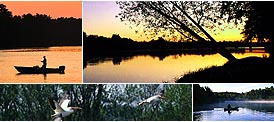
| Redfish | Sailfish | Sharks | Sheepshead | Snapper | Snook | Spanish Mackerel | Spotted Seatrout | Tarpon |

POMPANO
Regulations
Slot limit of not less than 10" or more than 20"; no closed season; aggregate limit of pompano and permit is 10 per person per day; may possess only one fish over 20"
General Information
This is definitely the most tasty member of the jack family. Pompano are very closely related to permit, and you will sometimes find both species schooling together close to shore along the west coast.
Distribution
Most pompano are caught within a half mile of the shoreline. Many are taken by anglers fishing from one of the ocean piers or from the surf. Pompano are year round residents in south Florida and summer residents in north Florida.
Tackle and Techniques
Seldom growing over three pounds, pompano are the perfect fish to go after with light tackle. You can even use ultra-light tackle with as light as 4-6 pound test line. The pompano's mouth is small so use a small hook, such as a # 1 or 1/0. Fly rodders can step down from their usual 8 to 9 weight rigs and use a 7 weight line and corresponding rod and reel.
Bait
Pompano feed on crustacean and one of their favorites is a live sand flea. Tackle shops often have them frozen and those will work if you can't dig up a few live baits for yourself. Sand fleas are small crabs that live beneath the surface of the beach in the surf zone. It is easy to find them if you know what to look for. As the waves recede off the beach look for ripples or bubbles coming from the sand. They indicate the presence of sand fleas. To get then simply dig with your hands or use a a specially designed scoop to dig them up. Along the Atlantic coast, around the Melbourne and Cocoa Beach area, surf anglers like to use clams for bait. Live shrimp also works well.
Small jigs tipped with a piece of fresh dead shrimp is the most effective lure. Make your retrieve slow and try to bounce the jig across the bottom. This action stirs up the sand making the lure look like a small crustacean working its way along the bottom.












